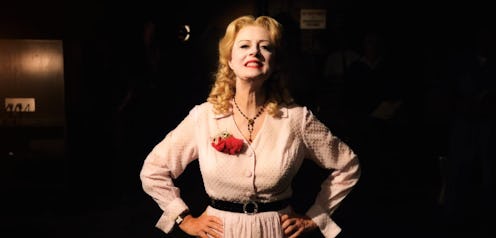
When Bette Davis first stepped on set of What Ever Happened to Baby Jane? transformed as Jane Hudson, director Robert Aldrich and the crew gave her a round of applause. At least that's how it was portrayed when Davis showed her Baby Jane costume on Feud. The praise was warranted as Davis' look became iconic since she fully embraced her mentally ill, heyday-seeking, and sadistic character Jane. Yet, Davis' costume could also be interpreted as an intentional insult toward her costar Crawford. Because even if the Baby Jane costume wasn't supposed to be making a mockery of Crawford in real life, Ryan Murphy's new FX anthology series is called Feud for a reason.
Throughout the first episode of Feud: Bette and Joan, Jessica Lange's Crawford was shown trying to preserve the remnants of her former glory. Whether it was her status or image, Crawford seemed obsessed with how she was perceived by the public. That's why the aging star washed her face in ice and used lemons on her elbows — because she was unable to accept the fact that Hollywood did not want the older woman she had become. While you could just write off Crawford as delusional, Murphy's Feud shows that 1960s Hollywood's sexism and ageism (ahem, that doesn't mean it's still not an issue in today's Hollywood) played a huge part in this obsession. After all, Crawford was still a talented actress, even if she didn't look the same way she did when she starred in such films as Grand Hotel or Mildred Pierce.
Yet, as Joan Crawford seemed preoccupied with maintaining her waning youthful image, Susan Sarandon's Davis was less concerned with looks. I don't mean to imply that Feud portrays Davis as being any less vain than Crawford, it was just that Davis' vanity had more to do with talent and respect than beauty. So, when this pair of stars hit the set of Whatever Happened to Baby Jane?, Davis was openly frustrated that Crawford seemed more interested in how she would look on camera than creating an authentic performance.
In the show, Davis criticized Crawford for wearing shoulder pads and too much lipstick and then complained to Aldrich that her costar was wearing falsies. As Blanche Hudson in What Ever Happened to Baby Jane? had been confined to a wheelchair and never left her home for 20 years, Davis aggressively thought Crawford's appearance should match her character's experience.
In almost direct response to this, when it was time for Davis to create the look of Jane, she went in the complete opposite direction. At least according to Feud, she intentionally chose a blonde wig that Crawford had worn in a film years earlier with wicked glee. She then proceeded to smear on red lipstick, cake her face with white powder, and added a Clara Bow (who had been a contemporary of Crawford's) heart-shaped beauty mark. Davis epitomized the desperate look of a person who is trying to relive her glory days. As Sarandon's Davis said, she wanted to look demented — and she most certainly achieved it.
It's beyond harsh to allude that Crawford was like the mentally ill Jane, who was consumed with her desire to achieve the fame that she once had as a child star. However, there are some underlying themes in the film What Ever Happened to Baby Jane? that do echo what actually occurred to both Crawford and Davis in real life. Whether or they are in Hollywood or not, aging for many women can feel like a lose-lose situation — at least when it comes to appearance. Women are criticized for not aging gracefully if they actively try to look younger and can be viewed as "desperate" or "pathetic." Yet, if women don't put effort into their appearances as they age, they are often considered as having no value. In either case, older women are rarely looked at as desirable — and desirability unfairly equates to worth — as shown earlier in Feud when studio execs kept turning down Aldrich to make the film.
It's completely reasonable to view Davis' choice of costume as an example of what Alfred Molina's Aldrich had said to Davis before she accepted the role — that she's not afraid to "leap off a cliff" for her acting. But Murphy's Feud also makes it acceptable to wonder if Davis was using the grotesqueness of Baby Jane to pointedly criticize her costar Crawford for her vanity and unwillingness to let go of the past. Because, as Catherina Zeta-Jones' Olivia de Havilland had said, feuds are about pain — and nothing would be more painful than Davis preying on Crawford's insecurity.